As managing director of Los Angeles' Grand Avenue Committee, alumna Martha Welborne (M.Arch., MCP 1981) is currently overseeing a $2.05 billion project to revitalize downtown Los Angeles. Headed up by philanthropist Eli Broad and designed by Frank Gehry, the three-block development will feature a park, retail and office space, residential units (including affordable housing) and a luxury hotel--in all, about 80 vertical acres of development.
Welborne's work has ranged from individual building design to such large-scale planning projects as Los Angeles' surface transit project, an effort that led to the creation of the Metro Rapid bus system now running throughout Los Angeles County. Welborne has also been an associate partner, director of planning and managing director of the Los Angeles office of Skidmore, Owings and Merrill, leading the design of complex urban projects and overseeing all business operations for the 50-person office.
Currently an appointed member of the visiting committee for MIT's Department of Urban Studies and Planning, Welborne recently talked about her career:
Q: What are the toughest aspects of a project like this?
A: There are so many people involved. The hardest thing is to herd the cats, to keep everybody up to speed and moving in the same direction. And there are people at so many different levels of understanding about development process--there are politicians, bureaucrats, the press, community groups and the public at large. For each group there is a different agenda and a different set of land mines, any one of which might blow the project apart.
Q: What has kept you so engaged for these six years?
A: I've always loved the nitty-gritty of urban infrastructure projects, the building bones of a city.Â
Q: What's your best memory of MIT?
A: It was the time I spent in Room 10-485, where the students and faculty were all together. There was so much discussion and fun and debate that happened between the classes. It was very collaborative. We'd really test each other and learn to argue with each other, then go off and have a beer together. It was great for learning about process. It was also great for respecting authority but testing it continually.
Q: What is the most pressing challenge in your field?Â
A: Overemphasis on star architects and on the world of architecture purely as sculpture are eroding the base of architecture and undermining the ability of the profession to contribute as much as we might to society. There are cities to be built, there's a lot of work to be done. If architects don't want to engage in the political and social issues that shape our environment, then the profession risks becoming too narrow.
Q: How do you think MIT could be most helpful in meeting that challenge?
A: There are plenty of people at MIT who define the role of the designer very broadly and who are committed to educating people to be open-minded about the contribution they can make in life.






